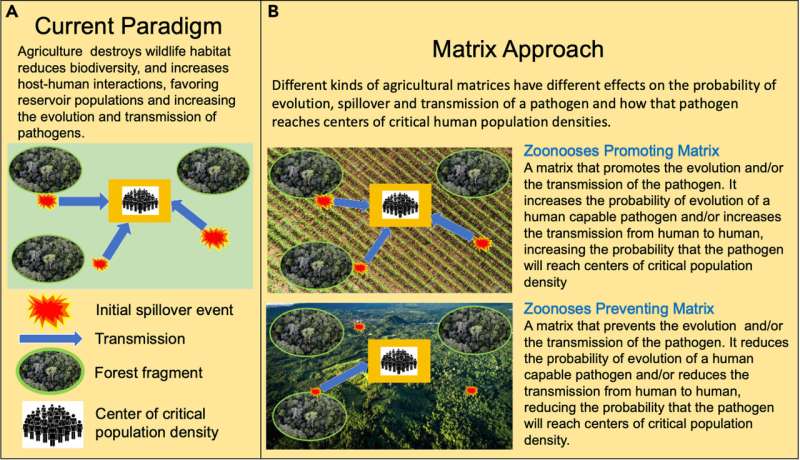This article has been reviewed according to Science X's editorial process and policies. Editors have highlighted the following attributes while ensuring the content's credibility:
fact-checked
peer-reviewed publication
trusted source
proofread
Incubator or barrier? Exploring the links between agriculture, biodiversity and the spread of pathogens

Many pathogens, including the virus that causes COVID-19, are thought to have originated in wild animals before spilling into human populations.
Agriculture is often blamed for accelerating this process, which is known as zoonotic spillover, through deforestation and habitat fragmentation that reduce biodiversity and increase the likelihood of contact between infected wildlife and humans.
But in a Perspectives article published online Sept. 15 in the journal One Earth, University of Michigan ecologist Ivette Perfecto and her colleagues argue that agriculture can both help and hinder: It can act as an incubator of novel animal-borne microbes, facilitating their evolution into human-ready pathogens, or it can form barriers that help block their spread.
To prevent zoonotic spread and spillover in the future, it's important to promote agricultural practices that boost biodiversity and create pathogen barriers, while minimizing conditions that form incubators, according to the authors.
"Many people assume that agriculture is always in conflict with biodiversity conservation, but that's not always the case," said Perfecto, a professor at the U-M School for Environment and Sustainability.
"It's true that large-scale industrial monocultures are notorious for destroying biodiversity. As biodiversity declines locally, the normally species-rich collection of animals is reduced to a few species that are likely to harbor pathogens that may already be—or certainly have the potential to evolve into—pathogens that can infect humans."
For example, monocultures of corn attract large populations of mice, which tend to harbor potential zoonotic pathogens. Palm-oil plantations attract large populations of bats that feed on palm fruits. Bats and mice are generally known sources of zoonoses, defined as infections or diseases that are transmissible from animals to humans.
In contrast, landscapes with small-scale and diversified farms "are much more likely to avoid the major problems associated with industrial agriculture," said Perfecto, who, along with U-M ecologist John Vandermeer, has spent more than three decades investigating the interrelationships between biodiversity conservation, biological pest control and food sovereignty at organic coffee farms in Mexico and Puerto Rico.
When it comes to biodiversity conservation, organic shaded coffee farms beat intensive-sun coffee plantations, just as multistory agroforestry systems outperform monocultural forestry plantations.
"Right now, there is an oversimplification of the complex social reality that impacts disease spread," said study co-author Luis Chaves of Indiana University. "Most diseases are impacted by this. Why do we have transmission hotspots in certain areas but not others, despite having similar environments? It's because both landscape change and how society works as a whole matter. Understanding this and reframing our thoughts is imperative to prevent future pandemics."
In their Perspectives article, Perfecto and colleagues present a novel "agricultural matrix framework" that can be used to examine the relationship between agriculture and zoonoses. The framework distinguishes between different types of agriculture and examines how characteristics of the matrix modulate species abundance and diversity, as well as species interactions, that facilitate or inhibit the evolution of a pathogen capable of infecting humans, and the subsequent spread of that pathogen to cities.
"To minimize the emergence of zoonotic diseases, we argue that there needs to be a focus on the entire agricultural matrix across the landscape, with its attendant rules of ecological and sociopolitical drivers," Perfecto said.
The sociopolitical factors are rarely considered in ongoing debates among ecologists about disease spread. But in the 21st century, the difference between low- and high-quality agricultural matrices often has less to do with the biology of the organisms living in a landscape than the sociopolitical and economic forces at play, according to Perfecto and colleagues.
The researchers say their proposed framework can lead to coherent, practical and effective actions that address interconnected problems of food security and sovereignty, biodiversity conservation, disease emergence, climate change and poverty.
More information: Ivette Perfecto et al, Looking beyond land-use and land-cover change: Zoonoses emerge in the agricultural matrix, One Earth (2023). DOI: 10.1016/j.oneear.2023.08.010
Journal information: One Earth
Provided by University of Michigan


















